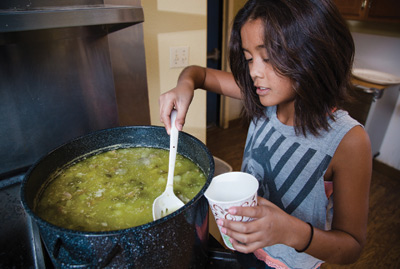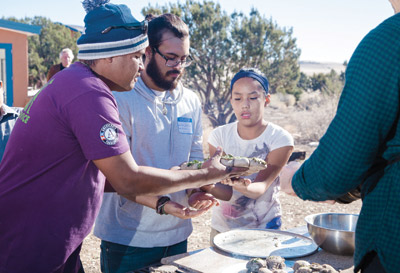 |
Canku Ota
|
 |
|
(Many Paths)
|
||
|
An Online Newsletter
Celebrating Native America
|
||
|
January 2016 - Volume
14 Number 1
|
||
|
|
||
|
STAR School Gives
Thanks By Giving Back
|
||
|
by Katherine Locke -
Navajo-Hopi Observer Reporter
|
||
|
credits: {photos by Ryan
Williams/NHO}
|
|
STAR School
students prepare Thanksgiving feast for community elders, focus
on traditional Native values
LEUPP, AZ - Instead of wearing feathers and fancy hats, STAR students got ready for Thanksgiving by cooking food from recipes they created themselves and then serving the food to the elders at a community feast. On this day, while debates about whether Native people should celebrate Thanksgiving at all were taking place, the students at STAR school were tending the fire outside and learning what kind of wood should be burned for baking bread in the outdoor ovens. They were in the kitchen tending to the soup as they prepared for the feast to begin while people from the community trickled into the large gymnasium. Dr. Mark Sorensen, co-founder and chief executive officer of STAR school, said it is important to recognize the not entirely accurate history that has been handed down about the Pilgrims. However, his first experience in his first year on the reservation, moved him. He was welcomed by a family on the reservation and taken in, taken to their sheep camp and on Thanksgiving they had a huge feast and an overnight ceremony. He was basically adopted into the family. "It was thanks that was expansive," Sorensen said. "It was not only letting me in, but asking me to be part of the strength of the family." Sorensen sees the importance in giving the students an alternative narrative about who they are and what they are doing right now as opposed to only what happened in Massachusetts. Thanksgiving is harvest time for Native cultures. "What we're doing now by inviting everyone from the community is, we have an abundance and we're sharing it," Sorensen said. "And it feels good." STAR School, which opened in 2001, is a charter elementary school located 25 miles east of Flagstaff, near the southwest corner of the Navajo Nation. It is a K-8 school with a 99 percent Native American student population. Just two students identify from a different cultural background. STAR (Service to all Relations) prides itself on incorporating values that go beyond traditional classroom activities, ones that reflect the Native American culture of its students. "We think data is important," Sorensen said. "But when you talk about data it is vital to talk about more than just standardized test scores." Sorensen said STAR students graduate high school with a higher grade point averages than the state average. The kids can attend five different high schools once they leave STAR school. And the percentage of kids who go on to attend a post-secondary school is higher than the national average as well. "They come back and tell us that it is because of the foundation they get here, the values and being seen for who you are," Sorensen said. "That is a measure of success." But success for the students at STAR school also means incorporating the knowledge they have gained at the school about healthy eating into a traditional Diné soup recipe, with added spices, the kids made and served at the event. It is a soup they can take home and make for their families in the future. "Kids going home to Thanksgiving where they can look back on, 'You know what I did at school? We baked bread in this bread oven and grandma you know what we did?' And grandma says, 'Wow, that's really something,'" Sorensen said. STAR school was recently named one of the top 41 innovative schools in America by Noodle, a comprehensive website for education and resources. It exists completely off the grid, powered by 245 solar panels and two wind generators. The school provides its own energy for phone service, Internet and electricity. It is that technological advance that in some ways brings the students closer to a reality in which their grandparents lived - one where it mattered what the weather was doing that day, what the season was and which wood was used to cook with. Day to day the kids learn about the limits of power - what a few cloudy days mean for the school's power and how to grow and prepare food, things that their elders already know. "The solar power thing is part of that," Sorensen said. "We're connected to these rays of sun that come in not just because it creates power but because it warms up our buildings. It's life. The other part is the cycles of nature. If it's cloudy it affects us. If it's rainy it affects us. If it's sunny it affects us." The important thing, Sorensen stressed, is that it teaches cultural values but puts those values in a contemporary context where the kids see the importance in their every day lives at the school as something they have experienced themselves and also may have a memory of doing with their grandparents. "If we're teaching the kids the importance of taking care of Mother Earth, which is a big thing for us here, eventually the kids are going to say, 'Where's our power come from? Are we part of the same Joseph City power plant? And they're burning coal,'" Sorensen said. "'Or are we responsible for that?' Not that this makes it better than other people, but it makes it so we can say, 'This is what we're doing, what do you think?'" It is those lessons and many more that students learn at STAR school and ones that Sorensen said he hopes they take into the future. "They've got to see that being Native is a modern thing," Sorensen said. "I hope the kids come out of here with roots and wings. I hope they come out feeling strong about our place, where we are and the place of Navajo people in the whole context of our country. Where they know the bad stuff that has happened but they also know people have made it through, in spite of all that." |
|||||
|
|
|
|
||
|
|
||
| Canku Ota is a free Newsletter celebrating Native America, its traditions and accomplishments . We do not provide subscriber or visitor names to anyone. Some articles presented in Canku Ota may contain copyright material. We have received appropriate permissions for republishing any articles. Material appearing here is distributed without profit or monetary gain to those who have expressed an interest. This is in accordance with Title 17 U.S.C. Section 107. | ||
|
Canku Ota is a copyright ©
2000 - 2015 of Vicki Williams Barry and Paul Barry.
|
||
 |
 |
|
|
The "Canku
Ota - A Newsletter Celebrating Native America" web site and
its design is the
|
||
|
Copyright ©
1999 - 2015 of Paul C. Barry.
|
||
|
All Rights Reserved.
|
||

